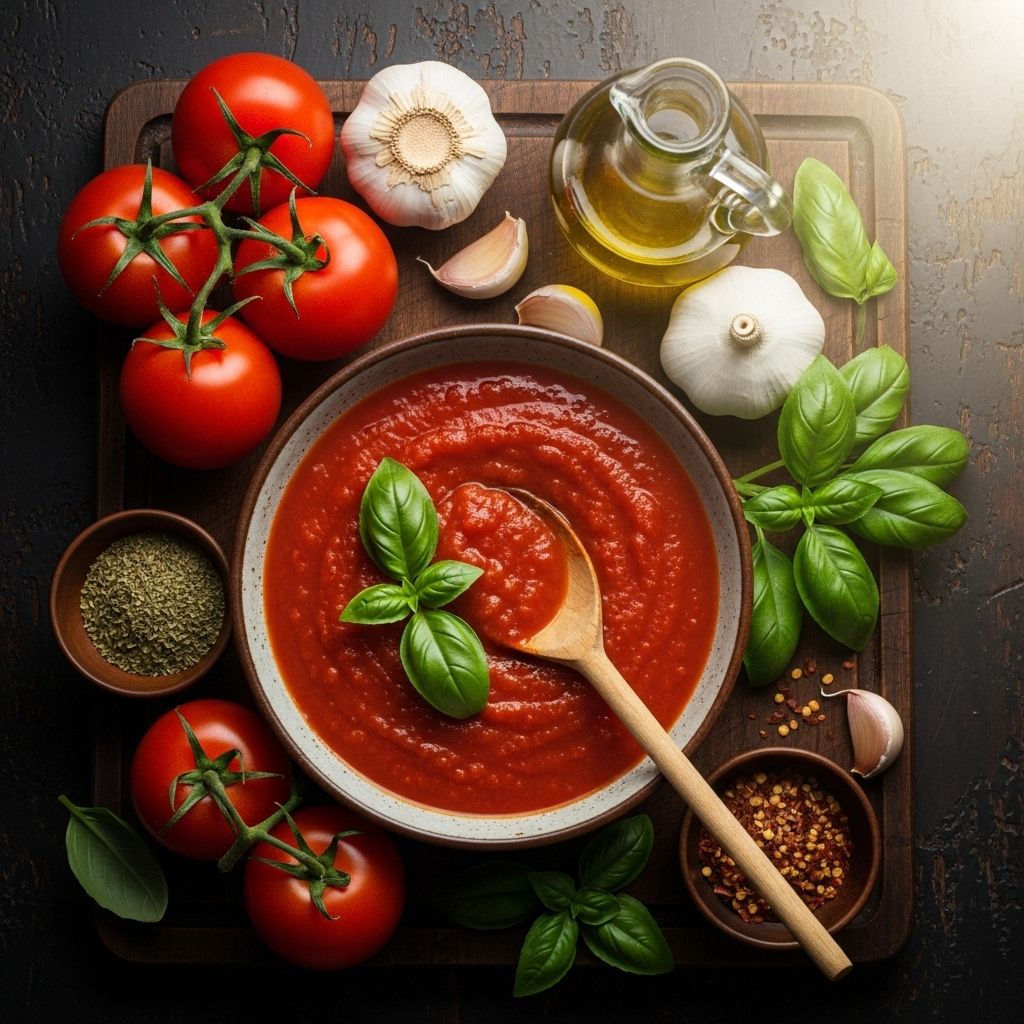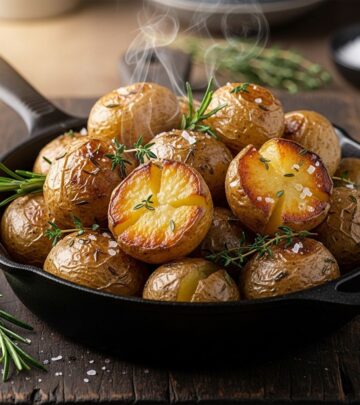Classic Homemade Marinara Sauce Recipe – The Pioneer Woman Style
Slow-simmered tomatoes and herbs meld into a velvety, kitchen-made staple for any occasion.

Introduction: The Allure of Homemade Marinara
There’s something magical about a pot of marinara sauce bubbling away on the stove, filling the kitchen with the rich aroma of tomatoes, garlic, and herbs. For many home chefs, making marinara from scratch is a rite of passage—a way to connect with tradition, creativity, and the simple pleasures of cooking. The Pioneer Woman, Ree Drummond, brings her signature warmth and practicality to this classic recipe, offering a version that’s both deeply satisfying and wonderfully adaptable.
What Sets This Marinara Sauce Apart
Unlike jarred sauces or quick-cooked tomato mixtures, Drummond’s marinara is all about slow development and layered flavors. It starts with fresh or canned tomatoes (whole or crushed), garlic, onions, and carrots for body and sweetness, then simmers patiently to allow the ingredients to meld. Herbs, a touch of sugar, and a splash of olive oil finish the sauce, yielding a balance of tangy, sweet, and savory notes that cling perfectly to pasta.
This recipe is forgiving, too: you can adjust the herbs, tweak the sweetness, and use what you have on hand without sacrificing results. It’s a formula for homemade sauce that feels special but requires no chef’s pedigree—just a little time and care.
The Ingredients: Building Blocks of Flavor
Here’s what you’ll need for a classic batch (scalable to taste):
- Canned tomatoes or fresh, ripe plum tomatoes (about 2 lbs if fresh)
- Olive oil for sautéing
- Onions and carrots, finely diced for sweetness and texture
- Garlic, minced for aromatic depth
- Tomato paste (optional, for extra body and richness)
- Fresh basil, oregano, and/or thyme (or dried, if preferred)
- Salt and pepper for seasoning
- Sugar, to taste (to balance acidity)
Feel free to experiment with herbs or add a pinch of red pepper flakes for heat. Drummond encourages cooks to make the recipe their own—because homemade marinara should reflect your tastes, not a rigid formula.
Step-by-Step Instructions: From Pot to Plate
Follow these steps for foolproof marinara every time:
1. Prep the Tomatoes
If using whole tomatoes, gently squeeze them by hand to break them up and release their juices. You can do this directly over the pot or in a bowl to avoid splatter. The goal is a rustic, chunky texture—don’t worry about perfection.
2. Sauté the Aromatics
Warm a generous glug of olive oil in a heavy-bottomed pot over medium heat. Add diced onions, carrots, and garlic, and sauté until softened and fragrant—about 4 to 5 minutes, stirring occasionally to prevent burning.
3. Add Tomatoes and Simmer
Pour in the prepared tomatoes, juice and all, and stir to combine. If you’d like a thicker, richer sauce, stir in 2 to 3 tablespoons of tomato paste at this stage. This optional step adds depth and a deeper red color to the finished sauce.
4. Season and Customize
Chop your chosen herbs finely (basil, oregano, thyme, or a mix) and add them to the pot, along with salt, pepper, and a pinch of sugar to taste. Drummond notes that the longer the sauce simmers, the more the herbs will mellow and brown—so chop them small for best results.
5. Low and Slow Cook
Reduce the heat to low and let the sauce simmer uncovered for 1 1/2 to 2 hours, stirring occasionally to prevent sticking. This slow cooking allows flavors to concentrate and the sauce to thicken naturally.
6. Final Adjustments
Taste and adjust the seasoning with more salt, sugar, or herbs as needed. For a silky finish, you can puree the sauce with an immersion blender, or leave it chunky for a rustic feel.
Serving Suggestions: Make It a Meal
This marinara shines as a pasta topper, but its uses are endless:
- Toss with spaghetti, penne, or your favorite pasta shape
- Layer in lasagna or baked ziti
- Spoon over grilled meats, fish, or roasted vegetables
- Use as a dipping sauce for garlic bread or mozzarella sticks
- Freeze in batches for future quick meals
Garnish with fresh basil, a drizzle of olive oil, and a generous sprinkle of grated Parmesan cheese for a restaurant-worthy finish.
Recipe Adaptations & Tips
Customize Your Flavor Profile
Marinara sauce is a blank canvas. Try these twists:
- Meaty Marinara: Brown ground beef, Italian sausage, or turkey with the onions for a heartier sauce.
- Vegan/Vegetarian: Skip meat and amp up the veggies—add diced bell peppers, zucchini, or mushrooms.
- Spicy Kick: Stir in red pepper flakes or a dash of hot sauce.
- Creamy Finish: Swirl in a bit of heavy cream or ricotta for a luxe, pink sauce.
Make-Ahead & Storage
Marinara sauce tastes even better the next day, as flavors continue to develop. Store cooled sauce in airtight containers in the refrigerator for up to 5 days, or freeze for up to 3 months. Reheat gently on the stove, adding a splash of water or broth if needed to loosen.
Common Marinara Sauce Mistakes to Avoid
- Overcooking the garlic: Sauté until just fragrant to avoid bitterness.
- Underseasoning: Taste and adjust salt and sugar throughout cooking.
- Too much liquid: Simmer uncovered to thicken; reserve tomato juice for adjusting consistency if needed.
- Neglecting fresh herbs: Add delicate herbs like basil at the end for a fresh pop.
Frequently Asked Questions (FAQs)
Q: Can I use fresh tomatoes instead of canned?
A: Absolutely! Use ripe, in-season tomatoes for the best flavor. Peel and seed them if you prefer a smoother texture.
Q: How do I make marinara sauce less acidic?
A: Add a pinch of sugar to balance acidity, or cook the sauce a bit longer to mellow the tomatoes.
Q: Can I freeze homemade marinara sauce?
A: Yes, marinara freezes beautifully. Cool completely, then transfer to freezer-safe containers or bags.
Q: What’s the best pasta for marinara sauce?
A: Sturdy shapes like spaghetti, penne, rigatoni, or fettuccine hold the sauce well, but any pasta works!
Q: How can I make my sauce thicker?
A: Simmer uncovered to reduce, or stir in a bit of tomato paste or simmer longer for a concentrated flavor.
Nutritional Highlights
Homemade marinara is naturally low in fat, packed with lycopene from tomatoes, and free from preservatives found in store-bought versions. Control the sodium and sugar to suit dietary needs, and enjoy a sauce that’s as wholesome as it is delicious.
Final Thoughts: Marinara as Family Tradition
Making marinara sauce from scratch is less about following a recipe to the letter and more about embracing the process, the aromas, and the joy of sharing a meal. As Ree Drummond shows, a great marinara is forgiving, flexible, and full of love—qualities that make it a staple in kitchens around the world.
Quick Reference Recipe Table
| Ingredient | Amount | Notes |
|---|---|---|
| Tomatoes (canned or fresh) | 2 lbs (or 2 large cans) | Squeeze to break up |
| Olive oil | 2–3 Tbsp | For sautéing |
| Onion | 1 medium, diced | Adds sweetness |
| Carrot | 1 large, diced | Optional, for depth |
| Garlic | 3–4 cloves, minced | Adjust to taste |
| Tomato paste | 2–3 Tbsp (optional) | For richness |
| Fresh basil/oregano/thyme | 2–3 Tbsp, chopped | Or use dried herbs |
| Salt | To taste | Start with 1 tsp |
| Black pepper | To taste | Freshly ground |
| Sugar | 1–2 tsp (optional) | Balances acidity |
Frequently Asked Questions (FAQs)
Q: What’s the difference between marinara and spaghetti sauce?
A: Marinara is a simple, quick-cooked tomato sauce with garlic, herbs, and olive oil. Spaghetti sauce often includes meat, more vegetables, and a longer simmer for deeper flavor.
Q: Do I need to peel the tomatoes?
A: For smooth sauce, yes; for rustic texture, no. It’s a matter of preference.
Q: Can I add wine to my marinara?
A: Yes, deglaze the pan with a splash of red or white wine after sautéing the aromatics for extra flavor.
Q: Can I make this sauce in a slow cooker?
A: Yes, sauté aromatics first, then combine all ingredients in the slow cooker and cook on low for 4–6 hours.
Q: What’s the easiest way to make marinara for a crowd?
A: Double or triple the recipe using large canned tomatoes for ease, and simmer in a big stockpot.
References
- https://www.thepioneerwoman.com/food-cooking/recipes/a11690/spaghetti-sauce/
- https://www.thepioneerwoman.com/food-cooking/recipes/a43660321/tomato-sauce-recipe/
- https://www.thepioneerwoman.com/food-cooking/recipes/a12097/marinara-sauce/
- https://www.youtube.com/watch?v=mo8S0pcf_wk
- https://www.youtube.com/watch?v=OOht1h2HUBY
Read full bio of Sneha Tete












